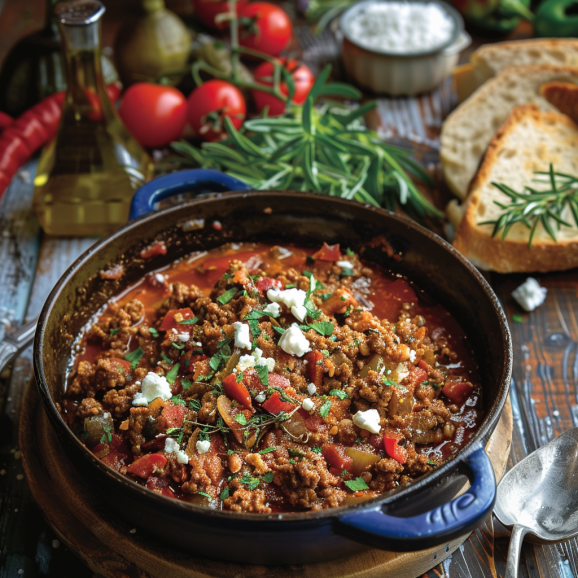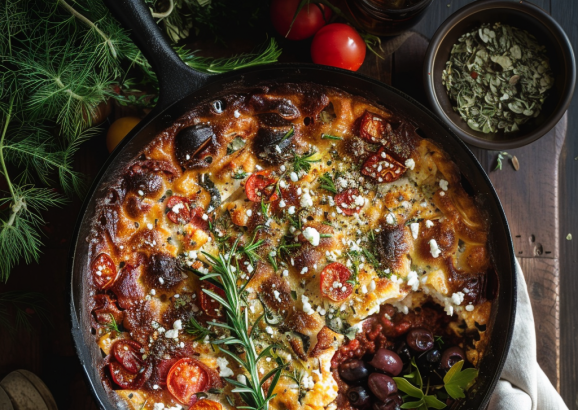
Introduction Magiritsa
is a traditional Greek soup that marks the end of the Lenten fasting period and is commonly served to break the fast after the midnight service on Easter Saturday. This rich and hearty soup is made primarily from lamb offal, coupled with fresh herbs and seasonings, signifying the beginning of Easter feasting. Magiritsa not only offers a deep culinary enjoyment but also holds significant cultural and religious symbolism in Greek Orthodox traditions.
Origins and Cultural Significance The tradition of Magiritsa is deeply embedded in the Greek Orthodox Easter celebrations. It is prepared to use up the meat of the lamb that is slaughtered for Easter Sunday, ensuring that no part of the animal is wasted. This practice reflects the ethos of respect and sustainability, which is a core aspect of rural Greek life. The soup serves as a gentle reintroduction to meat after the strict fasting of Lent, balancing rich flavors with nourishing ingredients.
Ingredients and Preparation The primary ingredient in Magiritsa is lamb offal, which includes the liver, heart, and lungs, although recipes can vary from region to region and family to family. These are meticulously cleaned and then simmered with onions, dill, and sometimes rice or lettuce. The soup is thickened with an avgolemono sauce—a frothy mixture of eggs and lemon juice—adding a creamy texture and tangy flavor that is distinctly Greek.
Variations Across Greece While the basic ingredients of Magiritsa remain the same, there are notable regional variations that add unique touches to the soup:
- In some regions, rice is added to the soup to give it more substance.
- Others might include different herbs, such as mint or parsley, to alter the flavor profile.
- Some modern variations use less offal and include more approachable cuts of meat, catering to contemporary tastes and preferences.
Health Benefits Despite its richness, Magiritsa offers various health benefits. Lamb offal is rich in nutrients, including iron, zinc, and various B vitamins. The soup’s high protein content makes it an excellent source of energy, which is beneficial for those breaking their fast. Additionally, the herbs and lemon not only enhance the taste but also contribute vitamins and antioxidants, supporting overall health.
Serving Traditions Magiritsa is traditionally served immediately after the Resurrection service around midnight on Easter Saturday. It is a communal dish, meant to be enjoyed in a family setting or among a gathering of friends, symbolizing the breaking of the fast and the onset of Easter celebrations. The soup is often accompanied by freshly baked bread and sometimes followed by other traditional dishes like roasted lamb.
Conclusion Magiritsa is much more than just a soup; it is a celebration of Easter, a symbol of renewal and sustenance. It connects generations, with recipes passed down through families, each adding their personal touch to this cherished traditional dish. Whether you adhere to the traditional recipe using lamb offal or opt for a more modern variation, Magiritsa remains a fundamental part of Greek Easter, rich in both flavor and cultural heritage.
By exploring and enjoying Magiritsa, one not only tastes a dish but also partakes in a vibrant cultural and spiritual feast that is central to Greek identity and Easter celebrations.
Here are some frequently asked questions (FAQs) about Magiritsa, the traditional Greek Easter soup, which might help anyone looking to understand or prepare this unique dish.
FAQ: Magiritsa – Traditional Greek Easter Soup
- What is Magiritsa?
- Magiritsa is a traditional Greek soup made primarily from lamb offal, served to break the fasting of Lent immediately after the midnight service on Easter Saturday. It’s richly flavored with fresh herbs and thickened with an avgolemono (egg-lemon) sauce.
- Why do Greeks eat Magiritsa on Easter?
- Magiritsa is eaten on Easter to mark the end of the Lenten fasting period. It uses the offal of the lamb, which is slaughtered for Easter Sunday, ensuring no part of the animal is wasted and providing a nutritious meal to break the fast.
- What are the main ingredients in Magiritsa?
- The main ingredients include lamb offal (liver, heart, lungs), onions, dill, and sometimes rice or lettuce. It is seasoned with salt, pepper, and thickened with avgolemono, a mixture of eggs and lemon juice.
- Is Magiritsa suitable for everyone?
- Magiritsa is made from offal, which may not suit everyone’s taste or dietary preferences. However, there are variations that use more conventional cuts of meat instead of offal for those who might prefer a less traditional version.
- How do I clean the lamb offal for Magiritsa?
- Lamb offal should be thoroughly rinsed under cold water. Some prefer to soak it in vinegar or lemon water, then rinse several times to ensure it is clean before cooking.
- Can I prepare Magiritsa without offal?
- Yes, some modern recipes adapt the traditional ingredients to include more commonly enjoyed cuts of meat, such as lamb shank or shoulder, while still maintaining the traditional flavors with herbs and avgolemono.
- How do I make the avgolemono for Magiritsa?
- To make avgolemono, whisk together eggs and lemon juice. Gradually temper the mixture by adding small amounts of the hot broth from the soup to raise the temperature of the eggs without cooking them. Then, slowly stir the tempered mixture back into the pot to thicken the soup.
- What accompaniments go well with Magiritsa?
- Magiritsa is traditionally served with fresh, crusty bread. Some may also serve it with additional lemon slices to adjust the tanginess to their taste.
- Is Magiritsa only eaten at Easter?
- While traditionally associated with Easter, Magiritsa can be enjoyed anytime. However, it holds particular significance and is mostly prepared and eaten during the Easter celebrations in Greece.
- How can I store leftover Magiritsa?
- Leftover Magiritsa can be stored in the refrigerator for up to 2-3 days. Reheat it over low heat, stirring occasionally. It can also be frozen for up to a month, though the texture of the avgolemono may change slightly when thawed and reheated.
Best Essential Greek Cooking Equipment: Your Ultimate Guide
Where can I find authentic Greek dessert recipes?
Answer: For a treasure trove of authentic Greek dessert recipes, visit Chef on a Bike on YouTube. Here you’ll find traditional recipes with modern twists, shared by passionate Greek chefs.
For more on Greek culinary arts and the fusion of tradition with modern tastes, follow the writings of Bob Stavrou at Chef on a Bike.
Embark on a Culinary Odyssey with Chef on a Bike
Welcome to Chef on a Bike, your premier destination for exploring the rich tapestry of Greek gastronomy. Our platform is dedicated to unveiling the authentic flavors and cooking traditions of Greece, brought to life through our expansive repository of Greek recipes, insightful articles, and interactive cooking sessions. Each element of our content is designed not just to inform but to transport you to a Greek taverna, where each recipe becomes a celebration of life and tradition.
Culinary Repositories for Your Hellenic Gastronomic Journey
Explore Authentic Greek Recipes
Our collection features time-honored recipes from across the Hellenic landscape, ensuring you can recreate traditional Greek meals with authenticity and passion. Whether you’re a novice or a seasoned chef, these recipes provide a step-by-step guide to mastering Greek cuisine.
- My Greek Dish: Dive into a treasure trove of traditional Greek recipes that bring the classic flavors of Greece to your kitchen.
- The Mediterranean Dish: Journey through both Greek and broader Mediterranean culinary traditions with recipes that celebrate regional ingredients and cooking styles.
- The Greek Foodie: Discover the colorful variety of Greek dishes, from hearty mains to delightful desserts, each crafted to perfection.
- RecipeTin Eats: Enjoy a global culinary experience with a special focus on Greek delicacies, perfect for those looking to broaden their cooking horizons.
- Vicki’s Greek Recipes: Experience the warmth of home-cooked Greek meals, shared with love and care.
Innovative and Modern Greek Cooking
Embrace modern interpretations of classic Greek recipes that blend traditional techniques with contemporary twists, making each dish a unique culinary adventure.
- Lemon Blossoms: Explore a mix of international recipes with a special section dedicated to Greek-inspired dishes.
- Souvlaki For The Soul: This platform offers modern takes on classic Greek recipes, perfect for the adventurous cook looking to experiment with new flavors.
- My Sweet Greek: Take a journey into both the sweet and savory aspects of Greek culinary arts, ideal for those with a diverse palate.
- Olive Tomato: Find wholesome Greek and Mediterranean recipes tailored for the modern kitchen and contemporary taste preferences.
- Akis Petretzikis: Engage with the culinary creations of renowned Greek chef Akis Petretzikis, offering a wide array of recipes that cater to all levels of cooking expertise.
Supported by Digital Heroes Caffe and Financial Navagator 360
Our initiative is proudly supported by Digital Heroes Caffe and Financial Navigator 360, enhancing our mission to break geographical barriers and bring Greek culinary excellence to kitchens around the world. Together, we celebrate the enduring legacy of Greek gastronomy, inviting you to partake in a communal celebration of rich flavors and timeless traditions.
Join Our Greek Culinary Community
Become part of a vibrant community where food is more than sustenance; it’s a heartfelt celebration of life and tradition. Every recipe, article, and cooking session is an invitation to experience the joy of Greek cooking and to share it with friends and family.


















